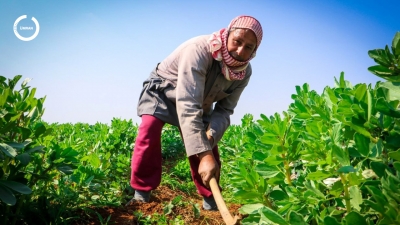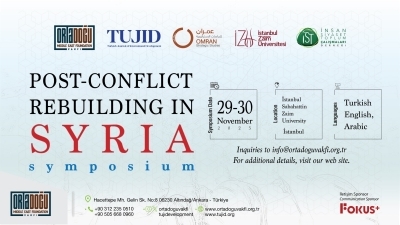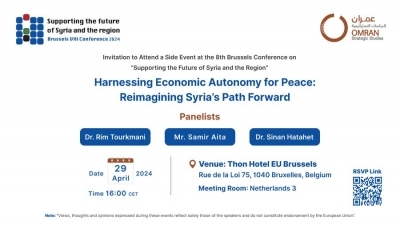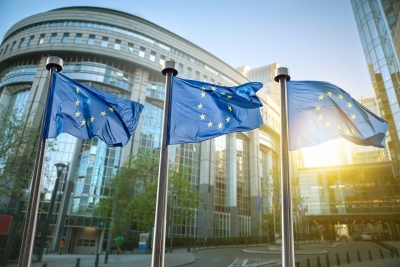Executive Summary
- Throughout 2023, northwestern Syria, particularly Aleppo and Idlib provinces, witnessed the implementation of 5,178 projects. The finance sector was in the lead registering 2,914 projects, followed by 413 projects in social services sector. The electricity sector accounted for 357 projects, transportation and communications for 338 projects, and water and sanitation services for 327 projects.
- Approximately 68% of these projects were conducted in rural Aleppo. Atarib was the most active locality, followed by Jarablus with 661 projects, and Idlib with 636 projects.
- Following the catastrophic earthquake that struck Syria and Turkey on February 6, 2023, local councils and organizations swiftly moved beyond the initial shock. They managed to carry out diverse projects across various sectors, demonstrating the resilience of the local community in challenging circumstances.
- Efforts were focused on social services and internal displacement sectors to address the earthquake's impact and meet the needs of displaced populations. This included reconstructing schools and hospitals and establishing new facilities to improve living conditions and integrate displaced individuals into new communities.
- The agriculture and livestock sector continues to face significant challenges due to drought, rising cost of raw materials, and the migration of farmers. These issues make agricultural activities non-viable, reduce productivity, and threaten food security.
- The industrial sector faces numerous challenges, including the lack of essential legal documents such as establishment certificates, customs declarations, and health certificates. Additionally, high raw material and energy costs, along with marketing obstacles, further complicate the situation.
- The report proposes several measures and recommendations, including expanding efforts in the finance sector by supporting medium-scale and innovative projects that can drive production, generate employment opportunities, and increase income levels. It advocates for reduced electricity rates for factories to enhance the resilience and competitiveness of local products. Furthermore, it suggests offering financial and material incentives to manufacturers, removing marketing barriers, and broadening access to financial systems to stimulate industrial production and commercial activity.
The report faces a series of technical and research challenges, such as intermittent military tensions in Idlib and rural Aleppo, which directly threaten the "early recovery" process by delaying or halting project implementation. The absence of a statistical institution capable of collecting and organizing necessary data and providing accurate figures forces researchers to rely on monitoring activities conducted by organizations and local councils, a method that may lead to discrepancies in evaluating the recovery level.
Additionally, researchers encounter challenges due to the lack of comprehensive documentation of all activities by local councils and organizations on their official platforms due to security reasons. Moreover, there is a complete absence of data covering the private sector’s activities in the area, adding complexity to understanding and evaluating the full economic situation. It is also worth mentioning the ongoing controversy surrounding the funding of early recovery activities by the international community, which perceives such funding as potentially empowering the regime and contributing to reconstruction efforts. This could lead to the regime exploiting international recovery funds and politicizing them. Furthermore, there is a notable deficiency in international funding for recovery compared to funding for humanitarian needs.
This report defines "early recovery" based on several periodic reports by Omran Center since 2019. The concept refers to the efforts and projects conducted by governance bodies and non-governmental organizations aimed at rebuilding and enhancing economic and social capacities in the aftermath of a conflict. It helps bridge the gap between the humanitarian aid phase and the reconstruction phase, all in pursuit of achieving sustainable stability in a fragmented society and reducing dependency on external assistance.
A Comprehensive View of Achievements in 2023
In 2023, northwestern Aleppo and Idlib provinces, governed respectively by the Syrian Interim Government and the "Syrian Salvation Government," witnessed the implementation of 5,178 projects, as indicated by the map below. This represents a 10% increase compared to the previous year, 2022.
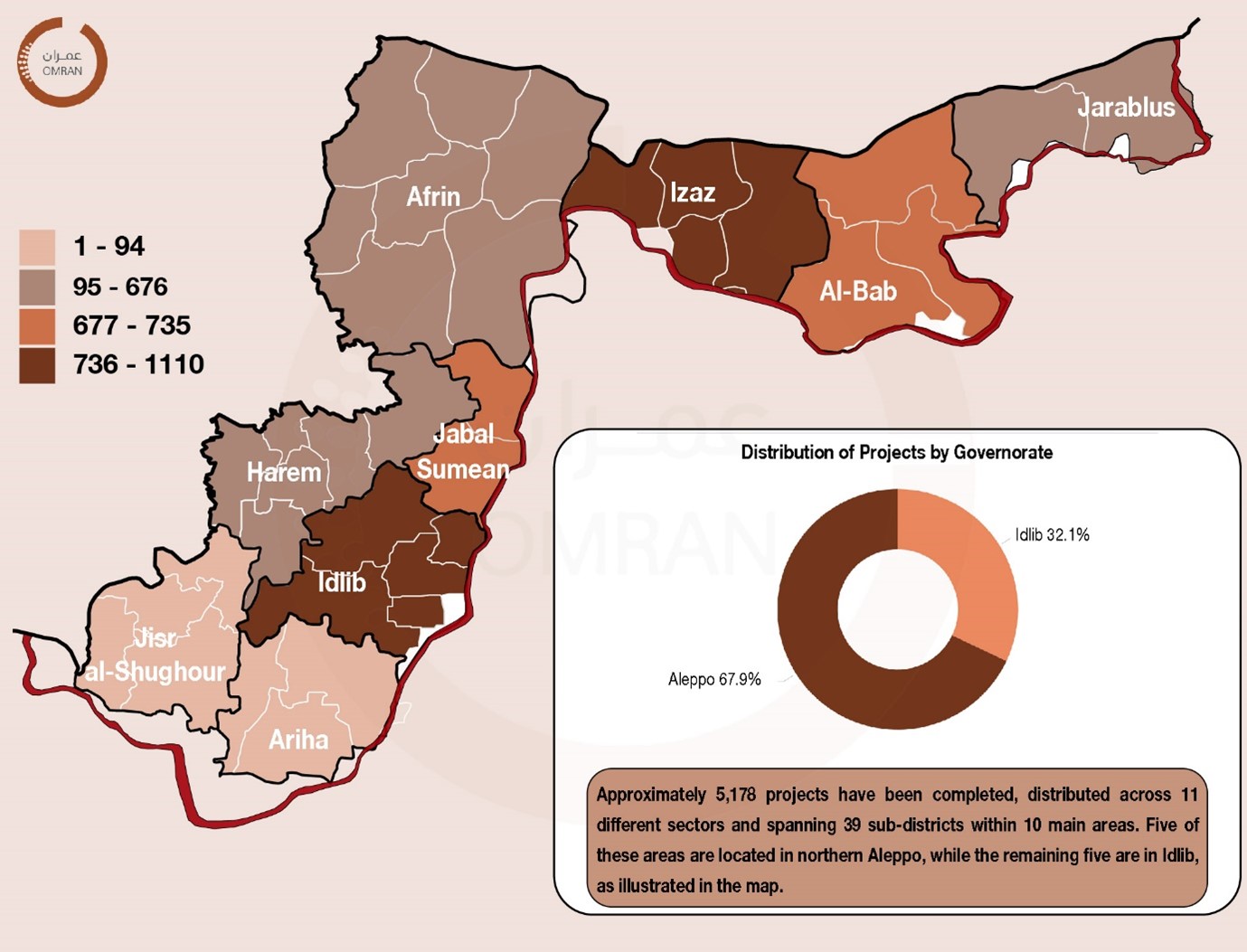
The finance sector was the most active, realizing 2,914 projects, followed by the social services sector with 413 projects and the electricity sector with 357 projects. The transportation and communications sector, along with water and sanitation, also saw significant activity, with 338 and 327 projects respectively. Meanwhile, the trade sector executed a total of 292 projects.

The data shows that rural Aleppo accounted for the largest portion of executed projects, with 68% (3,518 projects), compared to 32% (1,661 projects) in Idlib. This indicates a concentrated focus on developmental efforts in rural Aleppo over Idlib.
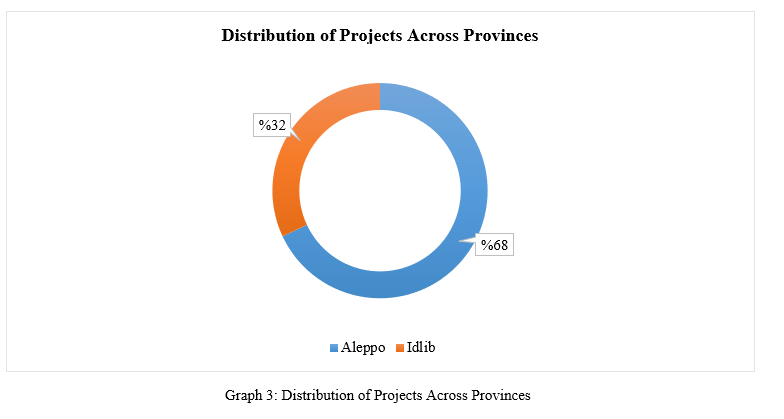
A deeper look into the distribution of projects across various regions and districts reveals that Atarib was the most active locality, followed by the cities of Jarablus, Idlib, A'zaz, and Al-Bab, as shown in Figure 4. The geographical concentration of projects in certain areas can be attributed to multiple factors: the presence of organizations in these districts, high population density, and large displaced populations, which increase the need for humanitarian and developmental projects. Additionally, favorable conditions for implementing projects in terms of security, available infrastructure, labor force, and proximity to logistical support centers further facilitated project implementation.
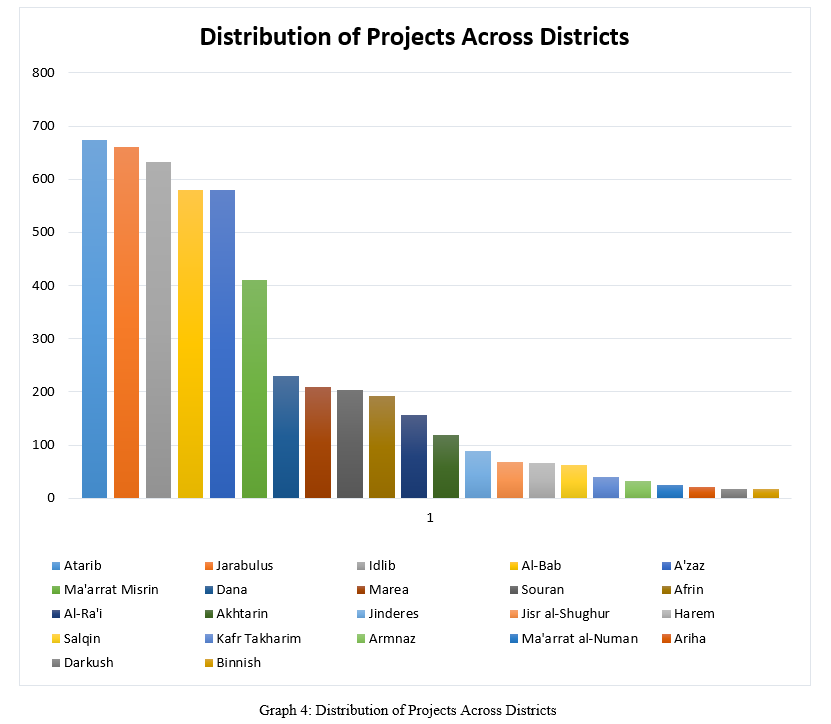
Among the significant events of 2023 that impacted the "early recovery" process was the devastating earthquake on February 6, 2023, which struck 137 cities and towns in rural Aleppo and Idlib, affecting over 1.8 million people, causing the deaths of 4,540 civilians, injuring about 12,000 individuals, and leaving 67 people missing. The disaster prompted the displacement of approximately 300,000 people, predominantly children and women. The earthquake also resulted in material losses, including the destruction of 433 schools and 73 health facilities, and the complete destruction of 1,867 buildings, with 8,731 homes and buildings partially damaged, according to figures from the "Support Coordination Unit".
In response to the earthquake, prominent organizations announced the formation of a "Joint Operations Alliance" consisting of "The Syrian Forum," "The Syrian American Medical Society," and "The Syrian Civil Defense" to coordinate efforts in addressing the disaster. Additionally, the Qatar Development Fund pledged support for the construction of a comprehensive city to shelter 70,000 people in northern Syria.
Economically, the transit fees for traders entering Turkish territories increased from $2,200 to $5,000 annually, which may impose financial burdens on traders and industrialists, potentially Shrinkage industrial and commercial businesses. A commercial court was established in Sarmada, Idlib, aimed at resolving commercial disputes among traders registered with the chambers of trade, covering intellectual property, bankruptcy, disputes related to commercial papers, currency exchange, commercial remittances, and banking activities.
Local councils in rural Aleppo seek alternatives for providing power at reasonable prices amidst the increasing suffering of residents and entities from rising electricity prices. They threatened electric companies to terminate contracts and applied increasing pressure, resulting in reduced subscription fees to 2.77 Turkish lira for homes and 3.17 TL for commercial in Jarablus, Afrin, and A'zaz, down from 4.24 TL for homes and 5.75 TL for commercial.
The Ministry of Finance in the Interim Government launched the first investment conference, aiming to develop the region, contribute to improving living standards, and increase employment opportunities. The Interim Government and the "Syrian Salvation Government" set the price of durum wheat at $330 per ton and soft wheat at $285 per ton, which is $100 less than the pricing in the "PYD" area, while the price in areas controlled by the regime is $222. Lastly, fluctuations in the Turkish lira negatively affected economic life and significantly slowed down commercial activity in Idlib and rural Aleppo.
A Look at the Sectors of Early Economic Recovery
In 2023, organizations implemented 2,914 projects within the finance sector, focusing particularly on areas such as A'zaz, Jebel Saman, Jarablus, Idlib, and Al-Bab, which saw the highest number of projects. The significant emphasis on the finance sector is due to the continuous operations of the “Hayat Fund,” “Syria Recovery Trust Fund,” and other organizations involved in direct cash interventions.
The growing interest in the finance sector plays a pivotal role in stimulating the economic recovery of the area by providing the necessary liquidity and supporting small and medium-sized enterprises, which in turn contributes to job creation and increases productivity. It also enhances social stability by enabling residents to improve their financial income, reduce poverty, diversify income sources, and reduce dependency on humanitarian aid and economic activities, increasing their resilience to economic shocks. Moreover, it develops the financial infrastructure of the area through the establishment of financial institutions capable of offering diverse financial services, encourages innovation, and entrepreneurship to develop emerging projects.
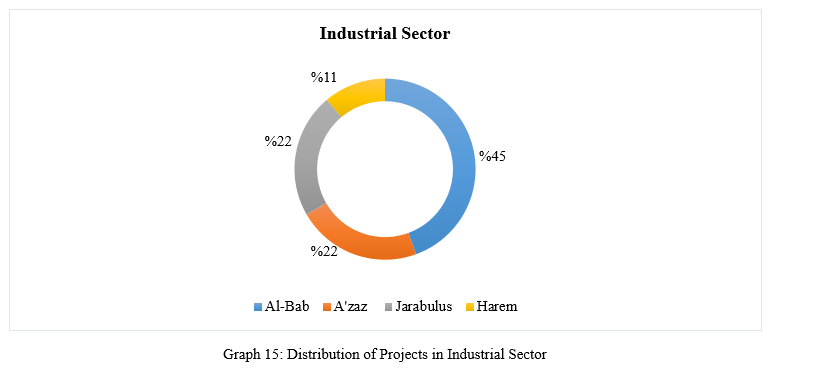
In the social services sector, 413 projects were implemented during 2023, marking an increase compared to previous years. This increase is primarily attributed to the urgent need to rehabilitate the health and education infrastructure severely damaged by the devastating earthquake on February 6. Organizations concentrated most of their budgets on repairing schools, hospitals, and public facilities such as bakeries, markets, and shops, which were either completely or partially damaged. New schools and hospitals were established, including Amanos University in Afrin, which encompasses several departments such as the College of Health Sciences, Nursing, Anesthesiology, Laboratory Analysis, and Radiography. This step underscores the critical importance of education in the processes of recovery and social rebuilding. Additionally, the removal of debris and damaged buildings continued, as civil defense teams executed a three-phase earthquake response plan. The first phase involved emergency response to search for survivors and retrieve the bodies of victims, clearing roads, securing risks from collapsing walls, and finally, debris removal.

357 projects were implemented within the electricity sector, particularly in Idlib, A'zaz, and Afrin. These projects included the rehabilitation of the electrical infrastructure through the maintenance of electric poles and transformers, the preparation and maintenance of medium and low voltage power lines, the installation of meters, and the extension of cables. The projects also included street and residential area lighting. Moreover, the reliance on renewable energy continued as organizations installed solar power systems for schools and hospitals, reflecting the pursuit of sustainability and the reduction of dependence on traditional energy sources.
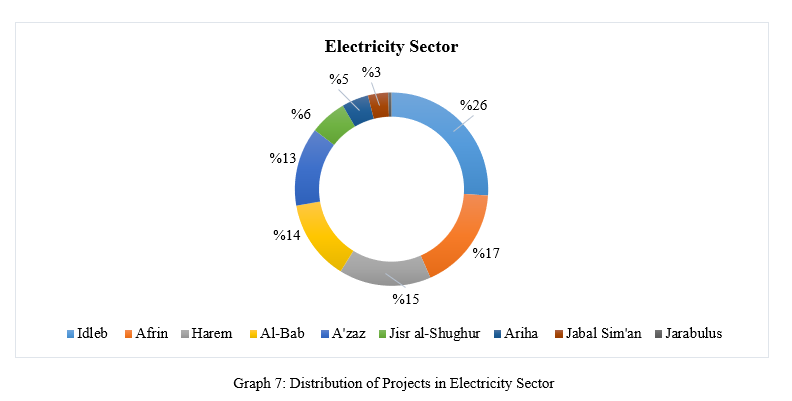
The transportation sector saw 338 projects, with Idlib, A'zaz, Harem, Al-Bab, and Afrin being the areas with the most projects completed. The continuous focus on these projects aimed at improving the infrastructure of roads in vital areas, reflecting the importance of the road network between cities and towns. This focus plays a pivotal role in facilitating the movement of goods and individuals, enhancing the connections between communities and markets, improving access to essential services, and bolstering the ability to reach educational and healthcare services. Among the main roads paved are: the international road connecting Idlib with Bab al-Hawa, the eastern corniche road in Ma'arrat Misrin spanning 800 meters, the road between Darkush and Ain al-Zarqa, the road between Kafr Karmin and Atarib, the road between Sarmada and Harem stretching 9,500 meters, and the third Afrin bridge, which is 1,650 meters long.
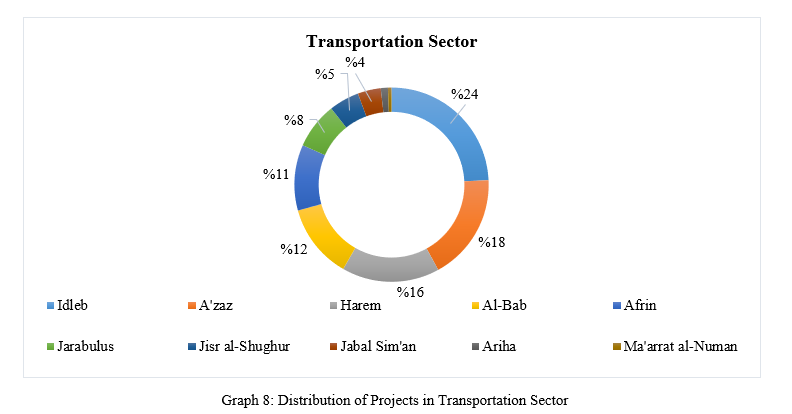
Within the water and sanitation sector, 327 projects were implemented. One of the most prominent projects in this sector was the inauguration by the Syrian Interim Government of a solar energy system for drinking water pumping stations in Al-Bab. This project, costing an estimated 2 million euros, has a production capacity of 1.15 megawatts, making it the largest service project of its kind. It utilized 2,547 solar panels to serve approximately 200,000 residents in Al-Bab, supported by the “Syria Recovery Trust Fund.” The use of solar energy to operate water pumping stations represents a major effort towards transitioning to renewable energy sources and environmental sustainability.
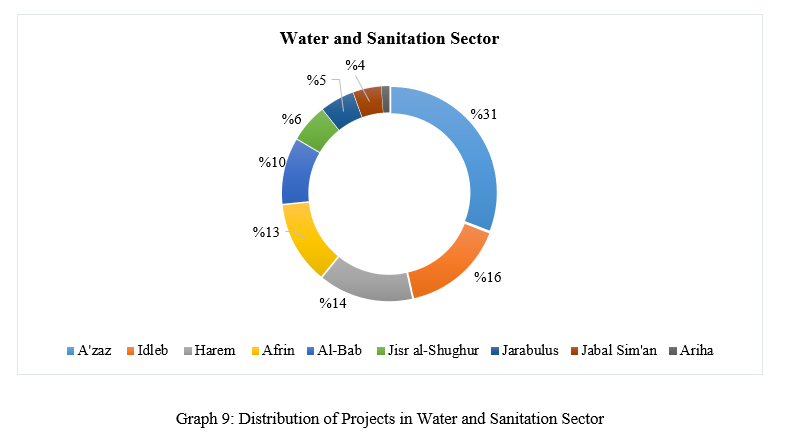
The trade sector saw approximately 292 projects implemented, with the majority concentrated in Idlib, reflecting its significance as a major commercial hub in the area. The projects executed in this sector encompassed a range of economic and service activities, including the tender contracts issued by organizations to supply various goods and execute various services. These included the supply of water, diesel fuel, electrical and medical equipment, book printing, stationery, and communication equipment, as well as car rental and other essential services. The reliance on tenders as a mechanism for implementing these projects enhances the standards of transparency and efficiency in selecting the best offers, thereby maximizing the possible value from available resources. It also facilitates cooperation between international and local organizations and the private sector, thereby strengthening the role of partnerships in the economic recovery process.
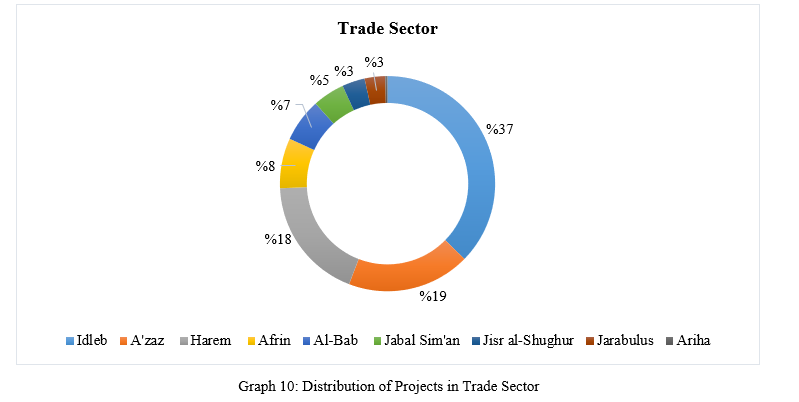
In the internal displacement sector, 256 projects were implemented, with a focus on Idlib, Harem, Afrin, A'zaz, and Al-Bab. These areas host the largest displaced populations and have become focal points for implementing projects aimed at improving infrastructure and living conditions for the displaced. The projects executed covered various aspects of essential services within the camps, including paving roads with gravel to facilitate movement and access, extending sewage networks to ensure sanitation and public health, and renovating homes to provide safer and more comfortable shelters.
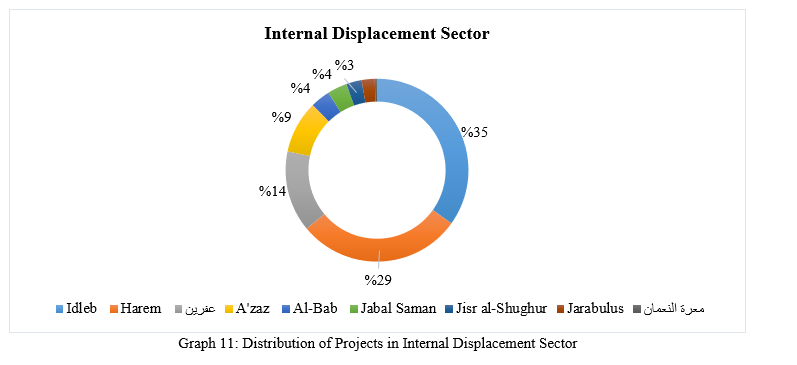
In 2023, 142 projects were carried out in the housing and construction sector, with the city of Al-Bab leading with 74 projects, as seen in previous reports, due to the common licensing granted for the construction of residential and commercial buildings. Organizations established several residential complexes aimed at improving living conditions for people residing in camps by relocating them to new buildings equipped with all essential services. These include the Al-Salam Complex, the third Al-Bonyan Residential Complex, and the villages of Rahma, Balsam, Al-Nasr, Qa'rqalbin, and Rawafid Al-Khair. The continuation of these projects is intended to alleviate the pressure on overcrowded camps and provide a relatively better living environment for the IDPs.
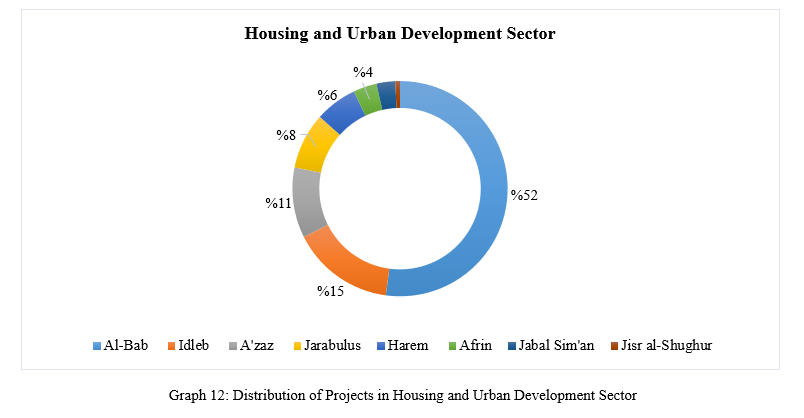
In the agriculture and livestock sector, 102 projects were implemented with notable support from the “Syrian Recovery Trust Fund.” This included the launch of an agricultural project aimed at supporting farmers in the cultivation of irrigated wheat over an area of 2,000 hectares, spread across towns and cities such as Al-Ghandoura, Al-Ra'i, Bza'a, Marea, and A'zaz. The Humanitarian Relief Authority provided support to 950 wheat farmers in Northern Rural Aleppo by supplying necessary agricultural inputs such as wheat seeds, superphosphate fertilizer, urea fertilizer, and diesel for irrigation, along with cash vouchers covering the costs of farming, irrigation, and harvesting. These efforts reflect a commitment to enhancing food security and supporting the local economy through the development of the agricultural sector, which is a fundamental pillar for the economic recovery of the region. It also contributes to creating job opportunities for farmers and enhancing their resilience against economic challenges. The importance of agricultural projects as drivers of economic growth and stability in rural communities is highlighted through the provision of resources and technical support to farmers, enabling them to improve their productivity and the quality of their crops, leading to self-sufficiency and reduced dependency on food imports.

In the telecommunications sector, 28 projects were implemented, including improving and expanding the telecommunications and internet infrastructure. Key projects featured the maintenance of main and subsidiary cables in the town of Binnish, with capacities of 450 lines for the main cable and 550 for the subsidiary, and the expansion of a subsidiary network for landline and internet services on Thalatheen Street in the city of Idlib. Additionally, the university communications center underwent expansions to the landline and internet networks to cover new areas such as Douar Al-Fallahin, along with extending internet cables throughout the city streets. The "Syrian Salvation Government" also launched mobile telecommunication services under the name SYRIA PHONE. This project represents a step towards enhancing communication services in Idlib. Providing strong and reliable communication networks is essential for achieving economic and social development, as it opens new prospects for education, business, and online services.
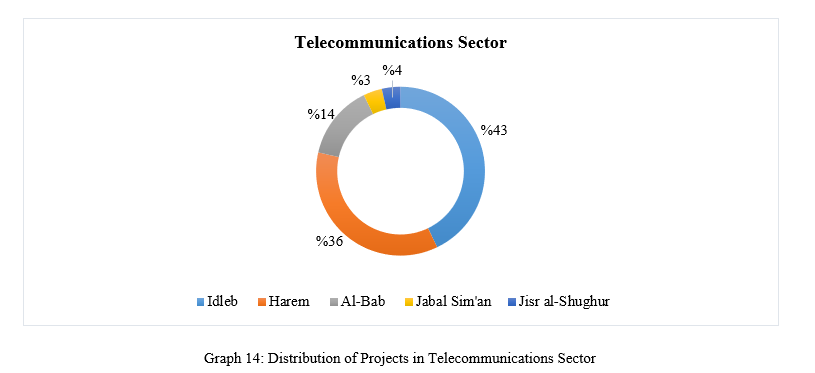
Finally, in the industrial sector, nine industrial projects were implemented in the area. Among these projects were the establishment of a factory for producing powdered infant milk in the industrial area of Al-Ra'i, a diaper production facility in Jarablus, and the first iron and profile production factory. Additionally, a cement factory in Al-Ra'i and an Indomie factory in the industrial city of Bab al-Hawa were established. Efforts were also made to complete the industrial city in A'zaz and to open the industrial city in Marea. Despite the industrial sector being a key pillar in recovery and a vital part of the economic stability strategy, which reduces dependence on imports and enhances competitiveness, the region still faces significant challenges that hinder the development of the industrial sector.

Results and Recommendations
The report addresses the efforts of early economic recovery in northwest Syria during 2023, focusing on the activities of local councils and organizations across 11 sectors. It covers improvements in sectors such as finance, agriculture, trade, and services, in addition to ongoing challenges in infrastructure and economic stability. From the data presented in the report, several conclusions related to recovery efforts in the region can be drawn, including:
- Overcoming the Earthquake's Effects: Despite the extensive destruction caused by the earthquake, the area managed to implement approximately 5,178 projects, underscoring the local community's resilience and recovery from the disaster's shock. The continuation of projects by local councils and NGOs contributes to the gradual transition from relief and humanitarian aid to early recovery. In this context, it is crucial to expand advocacy efforts to attract the attention of the international community and donors towards recovery, highlighting the importance of projects in all sectors and achieving economic and social stability in the area.
- Enhancing the Role of the Finance Sector: The finance sector played a significant role in supporting the early economic recovery process in 2023, providing job opportunities and diversifying household income sources. Financing small and medium-sized projects and providing direct financial support to families will contribute to economic independence and job creation. To ensure sustainability and optimal impact, it is essential to develop effective monitoring and evaluation systems and establish training programs to enable beneficiaries to manage their projects successfully.
- Improving Infrastructure: Projects implemented in the transportation, communications, water, and sanitation sectors played a pivotal role in supporting the area's economic recovery, particularly in road repairs and improving water supplies. However, challenges arising from population density and ongoing shelling targeting infrastructure, alongside drought issues, necessitate a more significant international effort in these sectors.
- Supporting Agriculture and Livestock: The agriculture sector faces complex challenges due to drought, rising raw material prices, labor migration, and reduced profitability of agricultural activities due to obstacles in exporting and marketing products. To address these challenges, it is crucial to support this sector by providing subsidized seeds, feed, equipment, and pesticides to reduce production costs, enhance crop marketing, integrate crops into food industries, and develop initiatives to promote them in foreign markets.
- Stimulating Industrial Growth: Providing a stable environment will attract significant investments and facilitate the operations of existing factories and workshops in the area, encouraging industrialists to relocate their operations from areas adjacent to Turkey to rural Aleppo and Idlib. This can only be achieved through reducing electricity prices, offering material and financial incentives to manufacturers, developing effective marketing and export strategies, and accessing the international financial system more extensively.
- Encouraging Small and Medium Enterprises: Given the current economic situation, it is essential to focus on developing workshops and small and medium-sized projects in the region, particularly in technical and computing fields, which are characterized by their flexibility, adaptability, and potential for marketing beyond borders.
- Addressing the Shortage of Humanitarian Aid Funds: Given the shortage of humanitarian aid funds from the international community, the region faces an urgent challenge that calls for adopting diverse and innovative financing strategies to achieve a degree of economic independence. Therefore, governance bodies and organizations should enhance investment tools, build a private sector and financial institutions, and conduct advocacy campaigns in expatriate countries to gather the necessary funding to implement economic plans.
In conclusion, the Interim Government, Local Councils and non-governmental local organizations managed the recovery phase with reasonable effectiveness in terms of resources, governance, and organization, despite the severe crises experienced in the region, especially the earthquake disaster on February 6, 2023. The implemented projects played a pivotal role in driving early economic recovery and ongoing development since the relative stabilization of the region after the years 2016 and 2018. However, there is an urgent need to develop an effective mechanism for an overall economic plan for the entire region (synchronized with other regions) that ensures the adoption of a specific economic model based on well-considered decisions and policies. This plan should address profound challenges such as the crisis of missing legal documents, water, electricity, industry, the financial environment including currency, pricing, and financial institutions, improving conditions for the displaced, and establishing a comprehensive legal framework to deal with vital issues and casesTop of Form.

